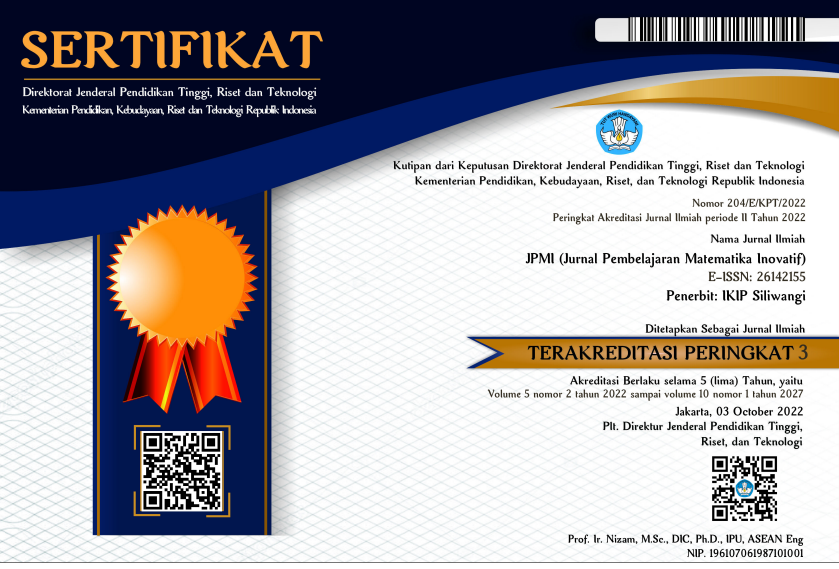PENCAPAIAN KEMAMPUAN BERPIKIR KRITIS MATEMATIS SISWA PADA MATERI TRIGONOMETRI
DOI:
https://doi.org/10.22460/jpmi.v4i2.p%25pKata Kunci:
Mathematical Critical Thinking, TrigonometryAbstrak
Referensi
Arikunto, S. (2005). Prosedur Penelitian Suatu Pendekatan Praktek. Jakarta: Gema Insani.
Ary, D., & Dkk. (2010). Introducation TO Research in Education. USA: Wadsworth.
As’ari, A. R., Mahmudi, A., & Nuerlaelah, E. (2017). Our Prospective Mathematic Teachers are Not Critical Thinkers Yet. Journal on Mathematics Education.
Depdikanas. (2006). Peraturan Menteri Pendidikan Nasional Republik Indonesia No. 20 Tahun 2006 Tentang Standar Isi . Jakarta: Depdiknas.
Ennis, R. (2015). The Nature of Critical Thinking: Outlines of General Critical Thinking Dispositionsand Abilities. New York.
Enny, C. M., & Tri, Y. W. (2012). Pengaruh Media Pembelajaran Geogebra Terhadap Motivasi dan Hasil Belajar Siswa. Yogyakarta.
Fisher, A. (2009). Berpikir Kritis Sebuah Pengantar. Jakarta: Erlangga.
Hobri, & dkk. (2017). Tingkat Kemampuan Berpikir Kritis Siswa Dalam Menyelesaikan Soal Barisan dan eret Aritmatika Di SMAN 5 Jember. Kadikma.
IEA's, T. a. (2016). Math Student Achivement Infographic Grade 4. Diakses Dari http://timms2015.org/download-center: TIMMS 2015.
Johnson, B. (2014). Critical Thingking. Jakarta: Erlangga.
Kemendikbud. (2013). Tujuan Pembelajaran Matematika . Jakarta: Kemendikbud.
Kemendikbud. (2020). Surat Edaran Menikbud No.4 Tahun 2020 Tentang Pelaksanaan Kebijakan Pendidikan Dalam Masa Darurat Penyebaran Corona Virus Disease (COVID-19). Jakarta: Kemendikbud.
Kurniawati, I. D., Wartono, & Diantoro, M. (2014). Pembelajaran Inkuari Terbimbing Integritas Peer Instruction Terhadap Penguasaan Konsep dan Kemampuan Berpikir Kritis Siswa. Jurnal pendidikan Fisika Indonesia .
Nurhayati, L., Zubaidah, S., & Diantoro, M. (2018). Analisis Kemampuan Berpikir Kritis Siswa SMP. Jurnal Pendidikan.
Rahayuningsih, S., & Kristiawan, I. (2018). Kemampuan Berpikir Kritis Siswa Dalam Menyelesaikan Masalah Matematika. CIASTEH.
Risah, Y., & Sutirna. (2019). Analisis Kemampuan Berpikir Kritis Siswa Sekolah Menengah Atas Dilihat Dari Hasil Belajar Pada Materi Trigonometri. Karawang: Prosiding Seminar Nasional Matematika dan Pendidikan Matematika.
Rusnah, & Tri, O. M. (2018). Meningkatkan Ketrampilan Berpikir Kritis Siswa Melalui Pendekatan Saintifik di Sekolah Dasar . Jurnal Gentala Pendidikan Dasar.
Somakim. (2011). Peningkatan Kemampuan Berpikir Kritis Siswa Sekolah Menengah pertama Dengan Menggunakan Pendidikan Matematika Kareno.
Sugiyono. (2018). Metode Penelitian Kuantitatif. Bandung: Alfabeta.
Tasyanti, T., & Restuti, A. T. (2016). Penerapan PBL Dengan Pendekatan RME Berbantuan Geogebra Untuk Meningkatkan Kemampuan Berpikir Matematis. Semarang.

















